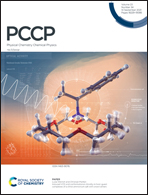Mechanistic insight into oxygen vacancy migration in SrFeO3−δ from DFT+U simulations†
Abstract
SrFeO3−δ is known to be an effective oxygen ion conductor and oxygen vacancies are central to its performance. SrFeO3−δ displays four crystallographic structural transitions as it undergoes oxygen reduction over a broad range of operating temperatures. In this work, systematic density functional theory calculations using the Hubbard U correction were performed to understand oxygen vacancy interactions and migration as a function of vacancy concentrations in SrFeO3−δ (δ = 0–0.5). We found strong repulsion between oxygen vacancies at close distance while these oxygen vacancies are stabilized at further distance. We also found that the oxygen migration is highly anisotropic and the calculated effective migration energy for the oxygen migration tends to be high and increases from 0.91 eV to 1.30 eV as δ goes from 0.125 (tetragonal phase) to 0.25 (orthorhombic phase). In the ordered brownmillerite SrFeO2.625, the oxygen migration is restricted in the one-dimensional channel because of the highly anisotropic nature of the crystal structure, resulting in the relatively low effective migration energy of 0.49 eV. This explains the experimental activation energy of 0.55 ± 0.05 eV. These results suggest the importance of regulating the oxygen migration path via the crystal structure design toward development of a SrFeO3−δ based fast oxygen conductor.



 Please wait while we load your content...
Please wait while we load your content...